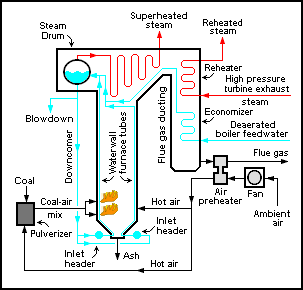Boiler used for generating steam or hot water has been designed in countless shapes, sizes, and configurations. An extensive terminology has evolved to describe their common features. Some of the definitions of terms are given below.
Shell:- Shell is the main container that contains water for steam usually made up of Steel plates bent into a cylindrical shape. The plates may be welded or reverted together.
Furnace:- The furnace is a firebox and is the space above the grate and below the boiler shell suitable area of furnace improves the efficiency of combustion.
Grate:- It is the platform upon which the fuel burnt. Generally, the grate is made up of cast iron bars evenly.
Water flow path:- It is the path followed by the water in the boiler.
Gas flow path:- It is the path followed by the flue gases of combustion. They may be water tubes or fire tube boilers. The gas flow path should be so arranged that it transferred maximum heat to the water to produce steam. This much affects the efficiency of the boiler.
Steam path:- Generally steam path is at the top of the shell to avoid water particles being carried with the steam. To do so, steam separators are used in the case of large capacity and high-pressure boilers.
Fitting ( Mountings):- The valves and gauges which are necessary for the safety of the boiler are referred to as mountings. Without mountings, a boiler cannot function safely.
Example:- Water level indicator, Pressure gauge, Fusible plug, Safety valve, Blow cock, etc.
Accessories:- The equipment which improves the efficiency of the boiler is known as accessories.
Example:-
- An economizer and air preheaters are used to extract maximum heat from the flue gases.
- A superheater is used to raise the temperature of steam above the saturation temperature.
Blowing off:- The process of removing the impurities floating on the water surface level is termed blowing off. Some special device is used to blow off impurities.
Settings:- Settings are the walls of the Furnace and combustion chamber. These are made up of fire bricks.
They form the passage through which the gases pass.
Water space and steam:- The volume of the shell, which occupies the water is known as water space. The level at which the water stands in the boiler shell is known as the water level.
The remaining volume of Shell that not occupied by water is called steam space





